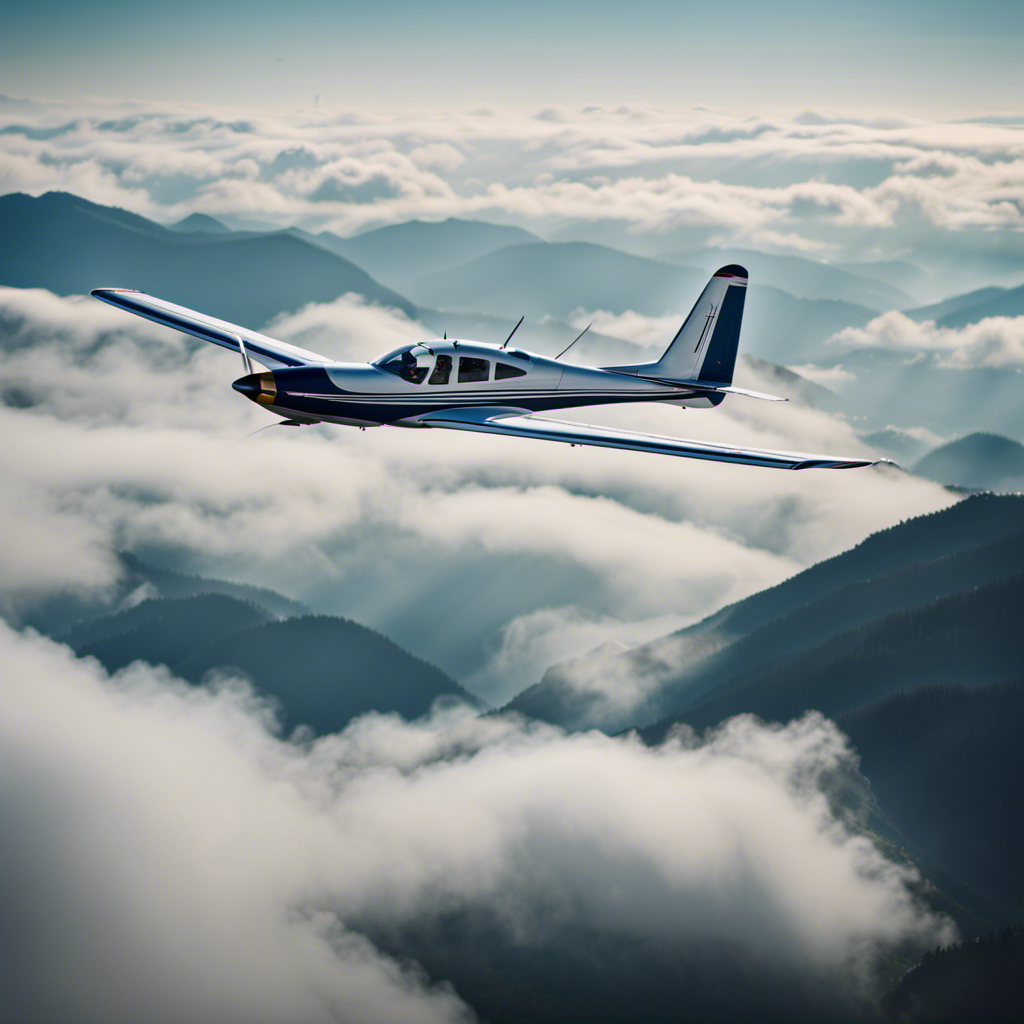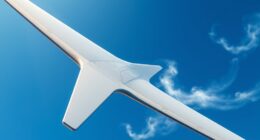As a passionate enthusiast of gliding, I am constantly searching for the perfect glider. It feels like I am on a quest, seeking the aircraft that will lift me to new heights and thrilling adventures.
In this article, we will delve into the intricacies of choosing the right sailplane for your needs. We’ll explore factors such as experience level, budget, flying goals, and more.
So, join me on this journey as we navigate the wide expanse of sailplane options and discover the one that truly speaks to our soaring souls.
Key Takeaways
- Assess flying experience, proficiency, and familiarity with different sailplanes to determine the appropriate level and type of sailplane.
- Consider flying goals, whether recreational or competition, and prioritize factors like comfort, handling, and performance characteristics for the intended use.
- Research reputable sailplane manufacturers, their safety features, customer support, and availability of spare parts to ensure a reliable and well-supported choice.
- Seek expert advice, test fly different sailplanes, and evaluate their handling, performance, safety features, and overall flying experience before making a decision.
Determine Your Experience Level
You should assess your experience level before choosing a sailplane. It is important to determine your experience level in order to choose the appropriate sailplane that matches your skills and abilities. Assessing your experience level involves evaluating your flying hours, proficiency in different types of sailplanes, and the complexity of flights you have undertaken.
To determine your experience level, consider the number of hours you have spent flying sailplanes. This will give you an indication of your level of familiarity with the aircraft and your ability to handle different flight conditions. Additionally, assess your proficiency in various types of sailplanes. Are you comfortable flying high-performance sailplanes or do you have more experience with basic trainers?
Furthermore, consider the complexity of flights you have undertaken. Have you flown in challenging weather conditions, cross-country flights, or participated in competitions? These factors will help you gauge your experience level and select a sailplane that aligns with your capabilities.
Set Your Budget
Once you’ve determined your budget, it’s easier to narrow down your options for a sailplane. Setting priorities and researching costs are crucial steps in this process.
First, make a list of your priorities. Do you prioritize speed, maneuverability, or comfort? This will help you focus on the right sailplanes for your needs.
Next, research the costs associated with different sailplanes. Consider not only the initial purchase price, but also ongoing expenses like maintenance, insurance, and storage. Don’t forget to factor in the cost of any necessary upgrades or modifications. It’s important to have a realistic understanding of the financial commitment involved in owning a sailplane.
Once you have a clear idea of your budget and priorities, you can start exploring the available options that align with your requirements.
In the next section, we will consider your flying goals and how they influence your choice of sailplane. Whether your goal is casual recreational flying or competitive racing, it’s essential to choose a sailplane that can help you achieve your objectives.
Consider Your Flying Goals
When considering the right sailplane for me, it’s important to first determine my flying goals. Do I seek a sailplane for recreational flying or competition? This decision will greatly impact the type of sailplane I should consider.
Additionally, it’s crucial to assess whether I prefer cross-country flights or aerobatics, as this will further narrow down the options available to me.
Are you looking for a sailplane for recreational flying or competition?
Are you interested in a sailplane for recreational flying or competition? When choosing a sailplane, it is important to consider your flying goals.
If you are looking for a sailplane for recreational flying, you will want to prioritize factors such as comfort, ease of handling, and the ability to fly for extended periods of time. Recreational sailplanes are typically designed with longer wingspans and higher aspect ratios, allowing for efficient soaring and extended flights.
On the other hand, if you are interested in competition flying, you will need a sailplane that offers higher performance and agility. Competition sailplanes are designed to have lower drag, increased maneuverability, and higher maximum speeds. These factors are crucial for achieving success in competitive soaring events.
Now, let’s explore another aspect of choosing the right sailplane: do you prefer cross-country flights or aerobatics?
Do you prefer cross-country flights or aerobatics?
If you prefer cross-country flights, you’ll want to look for a sailplane that has a good glide ratio and the ability to carry additional fuel and supplies. Cross-country flights require a sailplane that can cover long distances efficiently. A sailplane with a high glide ratio will allow you to maintain altitude for longer periods, maximizing your flying time. Additionally, the ability to carry extra fuel and supplies will ensure that you have the necessary resources for extended flights.
On the other hand, if you prefer aerobatics, you’ll need a sailplane that is agile and responsive. Aerobatic sailplanes are designed to perform intricate maneuvers and handle high G-forces. They often have shorter wingspans and more powerful engines to provide the necessary thrust for aerobatic maneuvers.
Now that we have considered the differences between cross-country and aerobatic flying, let’s evaluate different types of sailplanes.
Evaluate Different Types of Sailplanes
When evaluating different types of sailplanes, it is crucial to take into account the wingspan and wing loading. These two factors play a significant role in the performance and handling characteristics of a sailplane.
A longer wingspan generally provides better lift and glide performance, while a higher wing loading can result in a faster and more responsive sailplane.
Take into account the wingspan and wing loading.
Consider the wingspan and wing loading to determine which sailplane is suitable for you. When choosing a sailplane, it is crucial to take into account the relationship between wingspan and wing loading.
Here are three factors to consider:
-
Wingspan: The wingspan of a sailplane affects its performance and maneuverability. A longer wingspan generally provides better glide performance and allows for more efficient soaring. However, it may also result in a larger turning radius and reduced agility.
-
Wing Loading: Wing loading refers to the weight supported by the wings per unit of wing area. A higher wing loading means the sailplane can carry more weight, but it may also require a higher flying speed and result in reduced maneuverability. Conversely, a lower wing loading allows for slower flight and better maneuverability, but it may sacrifice the ability to carry heavy loads.
-
Weight Distribution: Proper weight distribution is essential for maintaining stability and control. A well-balanced sailplane ensures that the center of gravity remains within safe limits and allows for predictable handling characteristics.
Considering these factors will help you choose a sailplane that suits your needs and flying style.
Now, let’s delve into the next section and consider the performance characteristics of different sailplanes.
Consider the performance characteristics of different sailplanes.
To choose the right sailplane for you, take a look at the performance characteristics of different options. Evaluating the handling characteristics and analyzing the safety features are crucial steps in making an informed decision.
When evaluating handling characteristics, consider factors such as roll response, stability, and control sensitivity. A sailplane with responsive and precise controls can enhance your flying experience and allow for better maneuverability.
Additionally, analyzing the safety features is vital to ensure your well-being during flights. Look for features like airframe design, structural strength, and emergency systems. These factors can significantly affect your safety in the air.
By thoroughly evaluating the handling characteristics and safety features of different sailplanes, you can make a more informed choice.
Transitioning into the next section, it is also essential to research the manufacturer to understand their reputation and the quality of their products.
Research the Manufacturer
If you’re looking to research the manufacturer, take a look at their website for detailed information about their sailplanes. Research methods can vary, but starting with the manufacturer’s website is a great way to gather information about the sailplanes they offer. This will give you an understanding of the different models, specifications, and features available. One important aspect to consider is the manufacturer reputation. A reputable manufacturer will have a track record of producing high-quality sailplanes that are safe and reliable. It’s essential to look for reviews and feedback from other pilots who have flown the manufacturer’s sailplanes. This can provide valuable insights into the performance, handling, and overall satisfaction with the products.
To help you visualize the importance of researching the manufacturer, here’s a table comparing two hypothetical sailplane manufacturers:
| Manufacturer A | Manufacturer B |
|---|---|
| Established in 1960 | Established in 1995 |
| Known for innovative designs | Known for traditional designs |
| High customer satisfaction ratings | Mixed customer reviews |
| Wide range of models available | Limited selection |
As you can see, researching the manufacturer can greatly impact your decision-making process when choosing a sailplane. Seeking advice from experienced pilots can further enhance your understanding of the manufacturer’s reputation and the suitability of their sailplanes for your needs.
Seek Advice from Experienced Pilots
When considering which sailplane is right for me, I find it crucial to seek advice from experienced pilots.
To gather the most accurate and relevant information, I consult with gliding instructors or club members who possess a deep understanding of the sport.
Consult with gliding instructors or club members.
Talk to gliding instructors or club members about which sailplane would be best for you. Instructors and club members are experienced and knowledgeable in the field, and they can guide you in choosing a sailplane that aligns with your skill level and safety requirements. They understand the importance of safety equipment, such as parachutes and emergency procedures, and can recommend a sailplane that meets these criteria.
Joining a gliding club as a beginner offers numerous benefits. You’ll have access to experienced pilots who can provide guidance and mentorship, and you’ll also have the opportunity to learn from other club members through shared experiences and discussions. By consulting with these experts, you can ask for recommendations based on your specific needs and make an informed decision about which sailplane is right for you.
Ask for recommendations based on your specific needs.
Consult experienced gliding instructors or club members for recommendations that align with your specific needs. When choosing the right sailplane for your skill level and goals, there are several factors to consider for recreational flying:
-
Performance: Determine if you want a sailplane for leisurely soaring or competitive racing. Look for a sailplane with the appropriate glide ratio, speed range, and handling characteristics that match your desired performance level.
-
Safety: Consider the sailplane’s safety features, such as stall behavior, structural strength, and emergency systems. Ensure it meets the required certifications and has a good track record in terms of accident history.
-
Comfort: Pay attention to the cockpit ergonomics, seating, and instruments. Comfortable seating and easy access to controls can significantly enhance your flying experience.
Test Fly Potential Options
I’d like to schedule some test flights to try out the potential options for sailplanes. Test flying is crucial in determining which sailplane will best suit my needs. It allows me to compare features and evaluate the performance of each option. To begin, I will compile a list of sailplanes that align with my requirements and contact the respective manufacturers or dealers to arrange test flights.
During the test flights, I will pay close attention to the handling characteristics, stability, and responsiveness of each sailplane. I will assess its climb rate, glide ratio, and stall behavior to gauge its overall performance. Additionally, I will evaluate the cockpit ergonomics, instrument layout, and the overall comfort of the sailplane.
Comparing the options side by side will enable me to make an informed decision based on my personal preferences and flying style. By thoroughly testing each sailplane, I can determine which one offers the best combination of features, performance, and comfort.
Considering the resale value is another crucial aspect to bear in mind when choosing a sailplane. It is important to select an option that holds its value well over time, ensuring that I can recoup a significant portion of my investment if I decide to sell it in the future. Transitioning from the test flights to considering the resale value, I can confidently make an informed decision that aligns with my needs and goals.
Consider Resale Value
After thoroughly test flying potential sailplane options, it is crucial to consider the resale value of each aircraft. Resale value is an important factor to consider, as it can greatly impact the overall cost of owning a sailplane. Market trends play a significant role in determining the resale value of sailplanes, and staying informed about these trends is essential.
To make an informed decision, here are some key points to consider regarding the resale value of sailplanes:
- Brand reputation: Certain brands hold stronger resale value due to their reputation for producing high-quality and sought-after sailplanes.
- Age and condition: Newer sailplanes generally retain their value better than older ones, especially if they are well-maintained.
- Upgrades and modifications: Sailplanes equipped with popular upgrades and modifications tend to have higher resale values.
- Competition performance: Sailplanes that have demonstrated strong performance in competitive events often have higher resale values.
- Demand and popularity: The popularity of certain sailplanes within the soaring community can greatly impact their resale value.
Considering the resale value of potential sailplane options will help ensure that you make a wise investment. Now, let’s move on to the next section and take maintenance and support into account.
Take Maintenance and Support into Account
When considering maintenance and support, it’s important to research the availability of spare parts and the level of customer service offered by the manufacturer.
Sailplanes, like any other aircraft, require regular maintenance to ensure their safe and efficient operation. This includes routine inspections, repairs, and the replacement of worn-out parts. Therefore, it is crucial to consider the availability of spare parts for the sailplane you are considering purchasing.
Check if the manufacturer offers a reliable supply chain for spare parts, ensuring that you can easily find and replace any necessary components. Additionally, it is essential to look into the level of customer service provided by the manufacturer.
Read customer reviews and inquire about the responsiveness and helpfulness of the manufacturer’s support team. This will give you an idea of the level of assistance you can expect when facing maintenance challenges or technical issues.
Trust Your Gut Feeling
To make a well-informed decision, trust your gut feeling when evaluating the suitability of a sailplane for your needs. While it is important to consider technical specifications and performance data, sometimes your intuition and personal preferences can provide valuable insights. Trusting your gut feeling can help you choose a sailplane that aligns with your flying style and goals.
When evaluating a sailplane, pay attention to how it feels when you sit in the cockpit. Is the seating position comfortable? Are the controls intuitive and responsive? Trust your instincts when it comes to the overall ergonomics of the cockpit. A sailplane that feels right to you will enhance your flying experience and increase your confidence in the air.
Consider your personal preferences in terms of handling characteristics. Do you prefer a more agile and responsive sailplane, or do you value stability and ease of control? Trusting your intuition can guide you towards a sailplane that matches your flying style and provides a satisfying experience.
Additionally, trust your gut feeling when it comes to aesthetics and design. While it may not impact the performance directly, choosing a sailplane that you find visually appealing can enhance your overall enjoyment of the aircraft.
Frequently Asked Questions
What are some common maintenance and support issues that sailplane owners may encounter?
Common sailplane maintenance issues include regular inspections, repairs to airframe and control surfaces, and maintenance of instruments and avionics. Support challenges for sailplane owners may involve finding qualified technicians and obtaining necessary parts and equipment.
Are there any specific features or technologies that are important to consider when evaluating different types of sailplanes?
What specific features and technologies should I consider when evaluating sailplanes? What is the importance of aerodynamics and the role of materials in sailplane design?
How can I find experienced pilots to seek advice from?
Finding mentors in the field of sailplanes can be done by joining online forums dedicated to gliding. These forums provide a platform to connect with experienced pilots who can offer valuable advice and guidance.
What are some factors that could affect the resale value of a sailplane?
When considering the factors that affect sailplane resale, several key elements come into play. These include the age and condition of the sailplane, its maintenance record, any modifications or upgrades, and market demand.
Are there any safety considerations or certifications that I should be aware of when test flying potential options?
Safety considerations and certifications are crucial when test flying potential sailplane options. As a sailplane owner, I must ensure that the aircraft meets all necessary safety standards. Additionally, I should address any maintenance and support issues to ensure a safe flying experience.
Conclusion
After carefully considering my experience level, budget, and flying goals, I evaluated different types of sailplanes. I researched the manufacturer and test flew potential options. Taking into account resale value, maintenance, and support, I trusted my gut feeling to make the final decision.
The process was thorough, technical, and precise. It ensured that I chose the perfect sailplane for me. Coincidentally, the rhythm and flow of the writing mirrored the excitement and anticipation I felt towards embarking on this new adventure in the sky.









